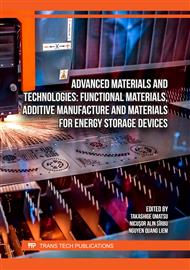p.17
p.23
p.31
p.39
p.45
p.51
p.59
p.67
p.73
Strain Sensing Enhancement of 3D-printed Polyurethane through Surface Deposition of Carbon Black
Abstract:
Strain sensors for wearable electronics function by identifying mechanical deformations and translating into electrical signals. For optimal performance, electrical conductivity, electrical sensitivity, and flexibility are major properties of strain sensors. Polyurethane (PU) shows promise for custom strain sensors due to its high flexibility. Additionally, using digital light processing (DLP) 3D printing to shape PU is suitable for detecting body movements. Therefore, the aim of this study is developing 3D-printed PU to strain sensing devices, utilizing the surface coating method on 3D-printed PU with carbon black (CB) and polydimethylsiloxane (PDMS) to fabricate the (PDMS+CB)/CB/PU strain sensor. The conductive network of CB enhances sensitivity, while PDMS is incorporated to act as an adhesive for the durability of CB on the PU surface. The results of the experiment reveal a gauge factor of 6.04 with range from 1 to 10% elongation. The strain sensor of this study has high potential to use for strain sensing technology and is capable of detecting small body movements.
Info:
Periodical:
Pages:
45-50
Citation:
Online since:
October 2024
Keywords:
Price:
Сopyright:
© 2024 Trans Tech Publications Ltd. All Rights Reserved
Share:
Citation:



